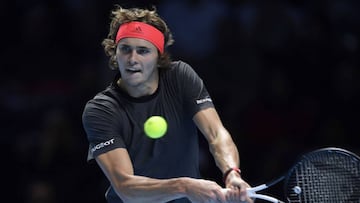Zverev, the new Messiah
The 21-year-old German neared perfection in London as he beat Novak Djokovic and Roger Federer and remains the greatest threat to the "big three."

Alex Zverev came close to perfection in London as he lifted his first ATP Finals trophy on Sunday. On only his second appearance in the season-ending finale, at the age of 21, the German shackled world number one Novak Djokovic in the final with the same assuredness as he had Roger Federer in the semi-finals a day earlier. The weight of 11 ATP Finals between his two opponents did not weight on Zverev’s shoulders, nor did the pecking order at the top of the game, where the inexorable victories of both have become so customary, and the new kid on the block pocketed 1,300 points as well as prize money of just over $2 million. Zverev completed his triumph under the watchful eye of his compatriot Boris Becker, a former coach to Djokovic and a three-times winner at the ATP Finals, his last success coming in 1995, a year and a half before Zverev was born. The German ends the year ranked fifth, just 135 points adrift of Federer, although last year he was number three when the curtain came down in London.
Now in his sixth season as a professional, Zverev has 10 ATP singles titles to his name (Saint Petersburg, Montpellier, Munich (2), Rome, Washington (2), Canada, Madrid and the ATP Finals), on all manner of surfaces: outdoor hard (3), clay (4) and indoor hard (2), underlining Zverez’s versatility and the effectiveness of his main weapons – his serve, delivered from an imposing height of 6ft 6in, and aggressive ground strokes. Furthermore, none of Zverev's major titles have come the easy way. He has beaten Djokovic in the two finals they have contested and holds a 2-2 record against the Serbian. Against the Swiss great, he has a 3-3 record overall and 1-1 in finals, also beating Federer in the two semi-finals they have played against each other.
Rafa Nadal still eludes him, the Spaniard boasting a 5-0 win-loss, although three of those matches were played on clay and there are few who can land a punch on the 11-times Roland Garros champion on his favoured surface. On hard courts Nadal and Zverez have not met since the last 32 at the 2017 Australian Open and that went to five sets. As yet the German has not made his mark at the four Grand Slams, the step up from three sets to five generally a proving ground that requires a mixture of shot-making and endurance. To date, Zverev’s best showing at a major was his run to the quarterfinals of this year’s French Open, where he was beaten by eventual finalist Dominic Thiem.
I recall a conversation I had with Óscar Borrás, a coach and creator of the Top Ten System, during which he explained to me the difference between a top 10 player and rest is not due to technical matters, but tactics. It was a conclusion drawn after three years of data analysis of the top players on the ATP Tour. Borrás focused his research on unforced errors, shots into the net and the number of consecutive points each player is able to withstand.
Zverev the standard-bearer for the generations coming through
His findings concluded that the only player who was likely to be able to challenge for the number one ranking against the current “big three” – Andy Murray’s injury problems have seen him drop to 262 in the world – is Zverez. The 21-year-old has now cemented his place as the leader of the next generation, a talented group but one that contains some of whom have fallen by the wayside and can now hardly be expected to be compared to the dominant quartet of the last decade.
When can the likes of Karen Khachanov, Borna Coric, Kyle Edmund, Stefanos Tsisipas, Daniil Medvedev, Hyeon Chung, Denis Shapovalov, Alex De Miniaur, Lucas Pouille, Nick Kyrgios, Nicolás Jarry and Frances Tiafoe take the next step? That is the question… All are in the top 50, most have had a breakthrough tournament and beaten top 10 players, but none have muscled in on the top table in the same way as Zverev.
Related stories
How many readers of this article can claim to be among the top three in their profession? I imagine very few, or none. And the same is true of the intermediate generation of tennis players, among which are many who the more pessimistic observers have already written off as not being up to the task of breaking that ceiling, among them Dominic Thiem, Kei Nishikori, Diego Schwartzman, Milos Raonic, Grigor Dimitrov, David Goffin, Pablo Carreño Busta and Ryan Harrison.
It is worth noting that we are talking about tennis, one of the toughest sports in the world in terms of technical difficulty, physical exertion, the psychological aspect and the demands of the calendar. Both of these under-30 generations are already there and there to stay. And preferences aside, Zverez continues to position himself as the most reliable of all of them; the anointed successor to the current top three. Although time is on his side it won’t be an easy task. But the obstacles in his way can make him an even better player than he is today.
